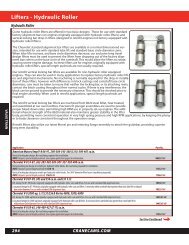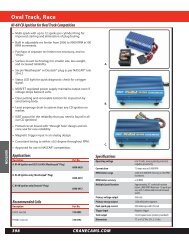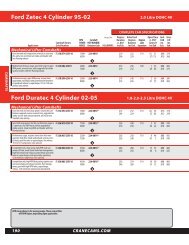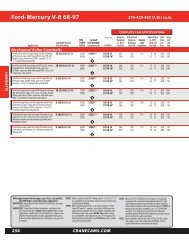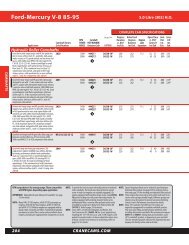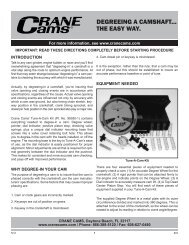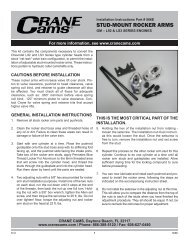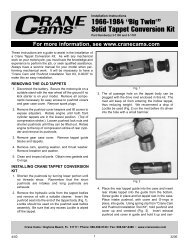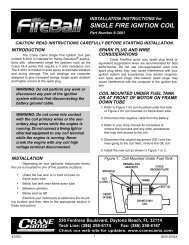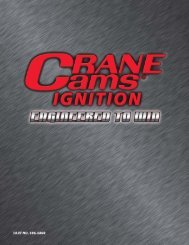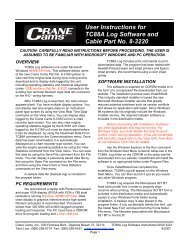2011 - Crane Cams
2011 - Crane Cams
2011 - Crane Cams
You also want an ePaper? Increase the reach of your titles
YUMPU automatically turns print PDFs into web optimized ePapers that Google loves.
1969-1993 351 (5.8L) cu.in. Windsor and 1982-<br />
1984 302 (5.0L) cu.in. H.O., also 1994-1997<br />
351W, and 302 SVO/351 SVO V8<br />
Another derivative in the Windsor family, the 351 engine<br />
blocks incorporate 1.3” taller deck heights to accommodate<br />
the increased displacement. Lifter bores are still inline, as<br />
are the valves in the cylinder heads, and the 1.6:1 rocker<br />
arm ratio is retained. Most notably, the firing order was<br />
changed to 1-3-7-2-6-5-4-8. Our 44 prefix designates these<br />
engines. The camshafts are dimensionally the same as the<br />
36 prefix, with the different firing order being the primary<br />
change. <strong>Cams</strong>hafts can be interchanged, providing the necessary<br />
changes are performed for the proper firing order.<br />
Additionally, the 1982-1984 302 H.O. engines also were<br />
equipped with hydraulic lifter camshafts having this revised<br />
firing order.<br />
We offer hydraulic, hydraulic roller (retrofit and OE style),<br />
mechanical, and mechanical roller camshafts and a wideranging<br />
line of valve train components for these engines.<br />
From 1969 to 1976, bottleneck 3/8 – 5/16” rocker arm studs<br />
were installed in the cylinder heads, resulting in a nonadjustable<br />
configuration. Our 99768-16 positive locking<br />
nuts will permit valve adjustment for these applications. In<br />
1977, a net lash pedestal mount rocker arm system was<br />
installed, continuing for the remainder of production<br />
through 1997. These pedestal mount rocker cylinder heads<br />
can be easily converted to an adjustable configuration for<br />
hydraulic and hydraulic roller street applications by using<br />
our Pushrod Guideplate Conversion Kits. Part number<br />
36655-16 provides for 3/8” stud mounted adjustable rocker<br />
arms, and 36656-16 is for 7/16” stud mounted rocker arms.<br />
No machining is necessary, and your standard pushrods can<br />
be maintained, thanks to the composite bushing inserts in<br />
the pushrod guideplates. For mechanical and mechanical<br />
roller applications, we advise the heads be machined for<br />
screw-in rocker arm studs and pushrod guideplates.<br />
1970-1982 351C-Boss 351-351M-400 cu.in. V8<br />
The Ford 335 engine family (commonly called the<br />
“Cleveland”) shared cylinder bore spacing dimensions, and<br />
the head bolt pattern with the Windsor engines, but few<br />
other parts are interchangeable. The inline lifter bores were<br />
retained, but they are at a different bank angle from the<br />
Windsor. Cam bearing sizes are also different, as are the distributor<br />
gear dimensions. The valves in the cylinder heads<br />
are canted (staggered), but the same length pushrods are<br />
used for the intake and exhaust valves. The rocker arm ratio<br />
is 1.73:1.<br />
These engines are designated by <strong>Crane</strong>’s 52 prefix. We offer<br />
hydraulic, retrofit hydraulic roller, mechanical, and mechanical<br />
roller camshafts for them. A wide-ranging line of valve<br />
train components is also available.<br />
The pedestal mount rocker cylinder heads can be easily<br />
converted to an adjustable configuration for hydraulic and<br />
hydraulic roller street applications by using our Pushrod<br />
Guideplate Conversion Kits. Part number 52655-16 provides<br />
for adjustable configuration 7/16” stud mounted rocker<br />
arms. No machining is necessary, and your standard<br />
pushrods can be maintained, thanks to the composite<br />
bushing inserts in the pushrod guideplates. For mechanical<br />
and mechanical roller applications, we advise the heads be<br />
machined for screw-in rocker arm studs and pushrod guideplates.<br />
The 1971 Boss 351 and 1972 351C H.O. featured cylinder<br />
heads with straight 7/16” rocker arm studs and pushrod<br />
guideplates, required for the mechanical lifter camshafts<br />
that were standard equipment.<br />
The Fontana Clevor block also uses our 52 prefix camshafts,<br />
not the 36 or 44 prefix Windsor style items.<br />
There can be a possible misapplication of components<br />
when choosing the proper retainers and valve stem locks<br />
for these engines. Although the valve stems are all 11/32”<br />
diameter, the configuration of the valve locks were<br />
changed. Note the following explanation to insure that the<br />
proper components are being used:<br />
1970-1977 351C-351M-400 - Intake and exhaust valves<br />
use multiple groove valve stem locks, having a large outside<br />
diameter, requiring the use of 3/8” type valve spring retainers.<br />
1971 Boss 351 / 1972 351C H.O. - Intake and exhaust<br />
valves use standard single groove valve stem locks, requiring<br />
the use of 11/32” valve spring retainers.<br />
1978 351M-400 - The intake valves use multiple groove<br />
valve stem locks, having a large outside diameter, requiring<br />
the use of 3/8” type valve spring retainers. The exhaust<br />
valves use standard single groove valve stem locks, requiring<br />
the use of 11/32” valve spring retainers.<br />
1979-1982 351M-400 - Intake and exhaust valves use<br />
standard single groove valve stem locks, requiring the use<br />
of 11/32” valve spring retainers.<br />
866-388-5120 • 386-236-9983 FAX 195



